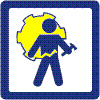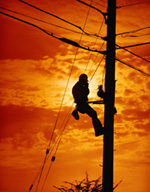|
traumatic
occupational injury
|
Electrical Safety |
|
|
Electrical current exposes workers to a serious, widespread occupational hazard; practically all members of the workforce are exposed to electrical energy during the performance of their daily duties, and electrocutions occur to workers in various job categories. Many workers are unaware of the potential electrical hazards present in their work environment, which makes them more vulnerable to the danger of electrocution. Electrical injuries consist of four main types: electrocution (fatal), electric shock, burns, and falls caused as a result of contact with electrical energy. |
| (from Worker Deaths by Electrocution: A Summary of Surveillance Findings and Investigative Case Reports.) | |
|
NIOSH Publications on Electrical Safety/Electrocutions: This student manual is part of a safety and health curriculum for secondary and post-secondary electrical trades courses. The manual is designed to engage the learner in recognizing, evaluating, and controlling hazards associated with electrical work. It was developed through extensive research with vocational instructors, and we are grateful for their valuable contributions. This Alert describes five fatal incidents in which workers contacted uncontrolled hazardous energy during installation, maintenance, service, or repair work. To prevent such deaths, the recommendations in this Alert should be followed by every employer, manager, supervisor, and worker who installs, maintains, services, or repairs machines, equipment, processes, or systems. This monograph summarizes surveillance data and investigative reports of fatal incidents involving workers who came into contact with electrical current. The surveillance data were derived from the National Traumatic Occupational Fatalities (NTOF) surveillance system maintained by NIOSH. The NTOF data are based on death certificates of workers 16 years or older who died from a traumatic injury in the workplace. The fatality investigations were conducted as part of the NIOSH Fatality Assessment and Control Evaluation (FACE) program. This Alert describes five cases (six electrocutions) that resulted from the hazards of operating cranes near overhead power lines and makes recommendations for preventing similar incidents. The Alert updates a previous NIOSH Alert published in July 1985 [NIOSH 1985]. This publication emphasizes the hazards from the use of metal-reinforced hydraulic hoses and aerial bucket trucks near energized power lines. Reports indicate that metal-reinforced hydraulic hoses may rupture and cause fires if they contact energized power lines. Electric current flowing through the metal reinforcement may also create an electrocution hazard. The Occupational Safety and Health Administration (OSHA) requires the use of non-conducting hydraulic hoses near energized power lines. This Alert describes eight incidents involving five electrocutions and three fatal falls of tree trimmers. NIOSH investigations conducted under the Fatality Assessment Control Evaluation (FACE) program suggest that many tree trimmers and their employers lack training and knowledge of Occupational Safety and Health Administration (OSHA) standards and may be unaware of the risk posed by inadequate or improper safety procedures and equipment. This Alert describes 13 deaths that occurred in six separate incidents when workers erected or moved scaffolds that came into contact with energized, overhead power lines, or when they contacted overhead power lines while using conductive tools or materials from scaffolds. To prevent such electrocutions, the recommendations in this Alert should be followed where scaffolds and conductive tools or materials are used near overhead power lines. This Alert describes six deaths that occurred because portable aluminum ladders, which conduct electrical current, came in contact with energized overhead power lines. If nonconductive ladders had been used instead, or if safe working clearances had been maintained, these deaths might have been prevented. This Alert describes two cases of workers who died as a result of feedback electrical energy, which is one cause of occupational electrocutions. Additional case reports are referenced whose circumstances are almost identical to those described. Evaluation of these cases identified three major areas of concern to prevent future incidents: (1) training in proper electrical procedures, (2) verification that power lines are de-energized and properly grounded before work is performed on them, and (3) detection of feedback electrical energy. This Alert describes recommendations that can be used to help save the lives of workers who contact electrical energy. Recent incidents have shown that electrocution victims can be revived if immediate cardiopulmonary resuscitation (CPR) or defibrillation is provided. While immediate defibrillation would be ideal, CPR given within approximately 4 minutes of the electrocution, followed by advanced cardiac life support (ACLS) measures within approximately 8 minutes, can be lifesaving. This Alert presents information on two fatal electrocutions that occurred as a result of using damaged receptacles and connectors. The investigations indicate that periodic inspection, recognition of hazards, and proper use of receptacles and connectors, and prompt repair of damaged connectors and receptacles, could prevent such incidents. This Alert describes two separate incidents that occurred while moving metal grain augers which resulted in five fatalities. The grain auger is an essential piece of farm equipment which is used to transfer grain from one location to another. However, every year electrocutions occur when this piece of equipment is improperly moved in the elevated position and it comes into contact with high voltage power lines. This Alert presents information on five cases which resulted in six fatal injuries involving crane-related electrocutions. NIOSH's findings concluded that full compliance with relevant OSHA standards and full use of the CSA-Ontario work practices would have prevented each fatality. This Alert includes one case of an accidental electrocution in a fast food restaurant. Electrical hazards in the kitchens of commercial restaurants are particular concern because of the variety of electrical appliances in use. NIOSH recommends that all workers, when hired, be made aware of electrical hazards and of safe work practices to be followed to avoid these hazards. Fatality Investigation Reports (conducted under the FACE Program) One of the initial emphasis areas for the FACE fatality investigation program was electrical-related fatality. Since the inception of the FACE program in 1982, hundreds of fatal incidents involving electrocutions have been investigated by NIOSH and State investigators. This link provides a list of those cases which in turn links to the full-text reports on the FACEWeb.
Other pages of interest: National Electrical Safety Foundation National Fire Protection Agency OSHA Technical Link for Electrical Safety OSHA Technical Link for Electrical Safety in the Construction Industry Touchstone Energy's Electrical Safety and Home and Work U.S. Consumer Product Safety Commission
|
|
| Traumatic Occupational Injury Home |

